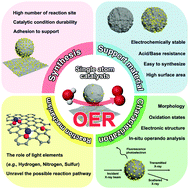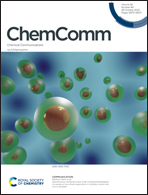Single-atom catalysts for the oxygen evolution reaction: recent developments and future perspectives
Abstract
Single-atom catalysts (SACs) possess the potential to achieve unique catalytic properties and remarkable catalytic mass activity by utilizing low-coordination and unsaturated active sites. However, smaller particles tend to aggregate into clusters or particles owing to their high surface energy. In addition, support materials that have strong interactions with isolated metal atoms, extremely large surface areas, and electrochemical stability are required. Therefore, sufficient information about these factors is needed to synthesize and utilize SACs. Herein, we review the recent investigations and advances in SACs for the oxygen evolution reaction (OER). We present not only the structural characterization of SACs, but also in situ/operando spectroscopic techniques and computational research for SACs to understand the mechanism and reveal the origin of their excellent OER activity. Furthermore, the OER catalytic activity and stability of SACs are summarized to evaluate the current level of SACs. Currently, research on single-atoms as OER catalysts is in the infant stage for synthesis, characterization and mechanism studies. We discuss some challenges for understanding the fundamentals of SACs and enhancing the catalytic performance of SACs for industrial applications.

- This article is part of the themed collection: (Photo)electrocatalysis for renewable energy


 Please wait while we load your content...
Please wait while we load your content...